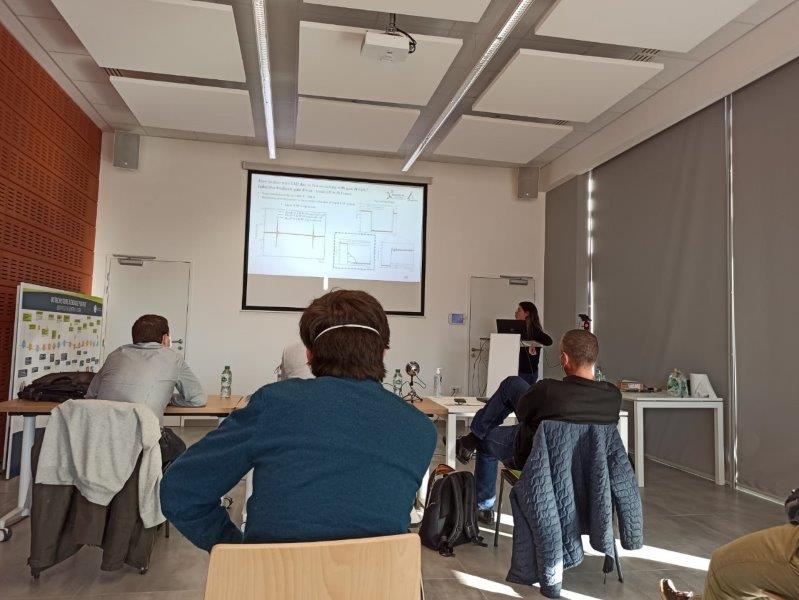PhD Hadiseh Geramirad
“EMC study of a 1.7 kV SiC MOSFET gate driver”
“EMC study of a 1.7 kV SiC MOSFET gate driver”

Abstract
The growing market for renewable energy technologies results in a fast growth in power electronic technologies. Most of the renewable energy technologies produce DC power therefore power electronic converters are needed to convert DC into AC power. Power electronic converters are widely used in voltage range up to +/-1MV and up to several GW power. Given the recent rapid growth in the performance of power semiconductors like Si, SiC and GaN power devices for high-efficiency power applications, there is a need for dedicated gate drivers to deal with SiC semiconductors in new converter generations. To meet the development of these applications, this research work has been carried out on the power electronic field presenting a gate driver for a half-bridge SiC MOSFET power module to be applied in a medium/high voltage power converter. The principle of converters operation are based on switching. SiC MOSFETs as the switching elements of the converters offer many advantages including low conduction losses, high speed and high voltage switching which increase the efficiency and power density of the converters. However, it brings some challenges for converter designers like increasing electromagnetic interferences which disturb the converter operation. Gate drivers provide interfaces between the control signal and switching actions in converters. They are also a path for electromagnetic interferences due to their isolated power supply. Gate drivers can be one of the elements which can act on switching transitions and reduce the generated electromagnetic interferences in converters. This reduce also the electromagnetic interferences passing through gate drivers. Therefore to keep the converter in its safe operation, this study targets two main objectives. First protecting gate drivers by limiting the amount of interferences passing through them which leads to keep the converters operation. Secondly reducing the generated electromagnetic interferences by means of gate driver at the semiconductor level by modifying the voltage waveform applied for driving semiconductors. Reaching these objectives results in improving the electromagnetic compatibility of converters.
At first, a commercial 1.7 kV SiC MOSFET half-bridge device is used as a switching leg in a 100 kW Dual Active Bridge DC/DC converter. The device is controlled by a commercial gate driver. The investigation in the converter prototype shows the importance of the conducted electromagnetic interferences passing through the gate drivers. The uncontrolled magnitude of the conducted electromagnetic interferences disturbs the triggering of the semiconductors which is called \self-disturbance”. It prevents the proper operation of the converter in rated voltage and power. Self-disturbance phenomenon highlights the effect of the gate drivers on the operation of the converter. This part of the study shows the need of new gate driver techniques to reduce the interferences from semiconductors. The second contribution addresses the challenge of gate perturbation due to fast switching in SiC MOSFET based converters. A well-known gate voltage perturbation issue due to the fast switching of semiconductors results in self-disturbance phenomenon. This problem is solved by a new circuit implemented in a classical gate driver architecture. It is proposed to filter the parasitic current flowing into the gate by a bifilar common-mode choke in addition of protection circuit. Thanks to this proposed method, the electromagnetic interferences passing through gate drivers are reduced. This part shows the sensitivity of the SiC MOSFET gate drivers design to parasitic elements and measurement probes. The performance of the classical differential probe compared with optical isolated voltage probe by measuring the gate-source voltage of semiconductors. It clarifies how the parasitic elements of the measurement probes affect the measurements and it leads to optimization of designs of the gate drivers. The final contribution is the development of a new driving technique. A new inductive feedback gate driver is designed based on the direct drain-source current measurement of the 1.7 kV SiC MOSFET power module. The dynamic adjustment of the gate current with this new gate driver technique reduces the generated interferences thanks to moderate switching voltage and current slops. The proposed gate driver achieves a better trade-off between losses and conducted emissions compared to the classical series- connected passive resistors for SiC MOSFET gate drivers.
Thesis director
Christian Vollaire


